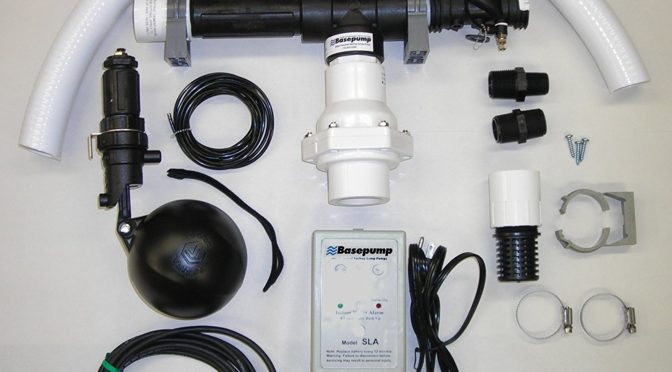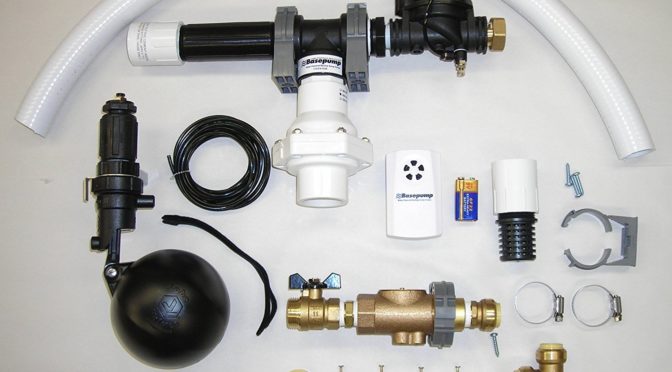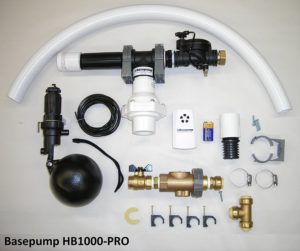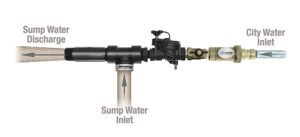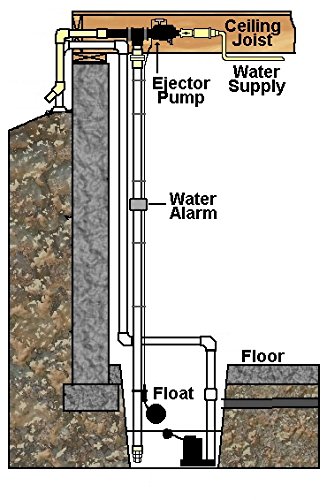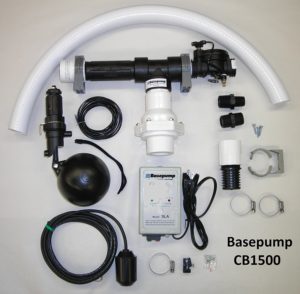 If you’re looking for a good sump pump, you can either spend a little money and replace whatever you get before long or spend a bit more and be set for the long haul. When it comes to AC powered main sump pumps, the best we’ve found is the Zoeller M267. For AC/DC combination sump pumps, it’s the Wayne WSSM40V. But what about when it comes to backup pumps? What’s worth spending your money on for long term peace of mind?
If you’re looking for a good sump pump, you can either spend a little money and replace whatever you get before long or spend a bit more and be set for the long haul. When it comes to AC powered main sump pumps, the best we’ve found is the Zoeller M267. For AC/DC combination sump pumps, it’s the Wayne WSSM40V. But what about when it comes to backup pumps? What’s worth spending your money on for long term peace of mind?
If you’re looking for a DC sump pump or the fastest backup pump overall, the answer is easy: it’s the Wayne WSM3300. But there are times when reliability is more important than speed, and as reliable as the WSM3300 is, it’s still not as reliable as a water-based sump pump. Simply never needing electricity and having no moving parts makes a water-powered sump pump nearly indestructible compared to a battery-based pump. We’ve reviewed a range of them lately, including our current favorites, the Basepump HB1000-PRO and Basepump HB1000. But we happen to know there’s still at least one water pump faster than these, and we made it our goal to review it today.
This brings us to the Basepump CB1500 Water Powered Backup Sump Pump. It’s not cheap, but as far as we’re concerned, it’s the best water-based sump pump on the market today. Our full review is below, but if you’re ready to buy it, which we’d recommend if you’re ready to be done with sump pumps for the next couple of decades, you can buy it here.
Key Features of the Basepump CB1500 (60 Second Summary)
 The Basepump CB1500 is a water-based backup sump pump, and one of the best on the market today. Like the HB1000/PRO it can serve as a standalone sump pump, but it’s most frequently seen in home and industrial applications due to its high speed and nearly indestructible levels of reliability. It needs no electricity, no batteries, and simply runs as long as you have city water pressure. Capable of pumping up to 2,000 gallons per hour of sump water (GPH), it’s also backed by a 5 year limited warranty by Basepump. The CB1500 weighs 6 pounds, is 16 inches long, 4.5 inches wide, and 9.5 inches tall.
The Basepump CB1500 is a water-based backup sump pump, and one of the best on the market today. Like the HB1000/PRO it can serve as a standalone sump pump, but it’s most frequently seen in home and industrial applications due to its high speed and nearly indestructible levels of reliability. It needs no electricity, no batteries, and simply runs as long as you have city water pressure. Capable of pumping up to 2,000 gallons per hour of sump water (GPH), it’s also backed by a 5 year limited warranty by Basepump. The CB1500 weighs 6 pounds, is 16 inches long, 4.5 inches wide, and 9.5 inches tall.
The CB1500 requires a 3/4 inch water supply, but 1 inch is recommended due to the volume of water necessary for it to function properly. It also requires a 1-1/3 inch discharge pipe and features a 1 inch sump intake. As with fellow Basepumps, it requires a municipal water pressure between 40 PSI and 90 PSI, and will remove two gallons of sump water for each gallon of pumped city water.
As is the case with other water pumps, the maximum water removal rate will vary with inlet water pressure and the required pumping head. The GPH is 1,400 at 40 PSI, which is the max pumping speed of the HB1000/PRO at 90 PSI. At 60 PSI, the GPH rises to 1,500, then to 1,700 at 80 PSI before topping out at 2,000 GPH at 90 PSI. The maximum head is reached at around 15 feet, although your specific results will vary with your inlet water pressure and piping configurations.
Like the HB1000/PRO, the CB1500 comes with a water alarm. However, unlike the lower models, the commercial high water alarm is both AC and DC powered; this preserves the 9 volt battery’s life for when it’s needed most (i.e., during power outages).
How Does the Basepump CB1500 Compare to the HB1000-PRO, HB1000, and the Wayne WSM3300?
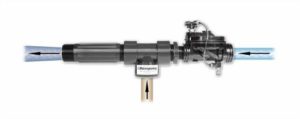 The most significant difference between the CB1500 and the HB1000/PRO involves water pumping speeds. The HB1000-PRO also has the advantage of including most of the necessary fittings and accessories for installation, while these must be purchased separately for the CB1500 and HB1000. The max pumping speed is significantly faster in the CB1500 than in the HB1000/PRO (2,000 GPH vs 1,400 GPH). Besides these differences, all three pumps are more or less the same.
The most significant difference between the CB1500 and the HB1000/PRO involves water pumping speeds. The HB1000-PRO also has the advantage of including most of the necessary fittings and accessories for installation, while these must be purchased separately for the CB1500 and HB1000. The max pumping speed is significantly faster in the CB1500 than in the HB1000/PRO (2,000 GPH vs 1,400 GPH). Besides these differences, all three pumps are more or less the same.
Compared to the WSM3300, the most distinguishing difference is the source of power. As with all water-based sump pumps, the CB1500 doesn’t require any source of electricity, unlike the WSM3300, which requires DC power to operate the sump pump and periodic AC power to recharge the DC deep cycle battery. Aside from this, the WSM3300 also includes a range of smart features not found in the CB1500, as well as a higher top speed (3,300 GPH vs 2,000 GPH) in water removal. The max pumping height is also slightly higher in the WSM3300 at 20 feet than that in the CB1500 at 15 feet.
Our Short and Long Term Experiences Installing and Using the Basepump CB1500
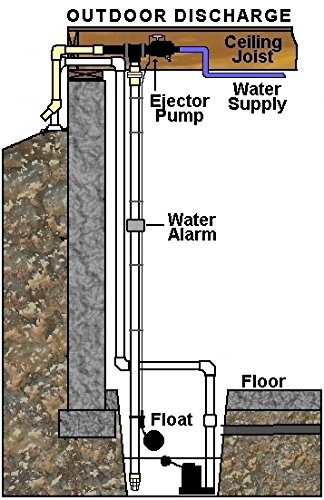 Installation is rather straightforward and can be expected to take about three hours with some prior plumbing experience. Keep in mind that you’re going to need to buy certain accessories including PEX tubing and SharkBite connectors unless you’re willing to sweat copper. The basic installation procedure is to first install the pump in a ceiling beam or joist in your basement. Once you’ve done that, the rest of the steps are similar to those in any other water-based backup sump pump. After shutting off your main water, you’ll connect the city water line to your sump pump’s water inlet (this is where push-to-fit connectors come in handy). You’ll then connect your sump pipe to the sump pump inlet and then you’ll connect the discharge pipe to the sump pump’s outlet. It’s possible to share a discharge pipe with your existing main sump pump, but it’s best to have separate discharges to avoid the risk of back flow if the check valve in your main sump pump fails.
Installation is rather straightforward and can be expected to take about three hours with some prior plumbing experience. Keep in mind that you’re going to need to buy certain accessories including PEX tubing and SharkBite connectors unless you’re willing to sweat copper. The basic installation procedure is to first install the pump in a ceiling beam or joist in your basement. Once you’ve done that, the rest of the steps are similar to those in any other water-based backup sump pump. After shutting off your main water, you’ll connect the city water line to your sump pump’s water inlet (this is where push-to-fit connectors come in handy). You’ll then connect your sump pipe to the sump pump inlet and then you’ll connect the discharge pipe to the sump pump’s outlet. It’s possible to share a discharge pipe with your existing main sump pump, but it’s best to have separate discharges to avoid the risk of back flow if the check valve in your main sump pump fails.
In terms of longevity, you’ve picked a good pump; it’s not uncommon to get more than two decades of problem-free functionality from a good water-based sump pump, and the CB1500 is as good of a candidate as we’ve found for the job. The main thing to keep in mind, as is the case with virtually every water-based sump pump on the market, is that you need to respect the water pressure limits and ensure you aren’t receiving more than 90 PSI from your municipal water line. If you are, you’re going to break seals in the pump and turn your basement into a water park, which is precisely what you’re aiming to prevent when buying a sump pump.
Troubleshooting and Installation Tips to Get Your Basepump CB1500 Working Sooner
Besides making sure you don’t have too much water pressure coming in through your water line, you’ll also want to make sure you have enough water. It’s a balancing act, and Basepump recommends the bucket test to take out the guess work. The test consists of seeing how long it takes to fill a 5 gallon bucket with 5 gallons of water (the fill line is typically around two inches below the lip of a bucket) when using an outside spigot. If it takes less than 20 seconds, you’re good to go. If it takes more than 20 but fewer than 30 seconds, you’d be better served with the HB1000-PRO. If it takes more than 30 but fewer than 40 seconds, you’ll want the RB 750-EZ. If your spigot has a frost free device, you’ll want to reduce your fill time requirements by 25% to get accurate data.
Basepump CB1500 Pros, Cons, and Value Comparison
In conclusion, we’re convinced the CB1500 is the best water-based sump pump on the market for under $400. It pumps more water than the HB1000/PRO while being as easy to install as the HB1000 and almost as easy to install as the PRO. It’s not perfect, of course, but nothing is. We’d like to see a PRO or EZ version in the future to make it even easier to install, and we’d also like to see a faster version in the future to keep up with the fastest battery-based sump pumps like the WSM3300.
But for now, if this is as good as it gets in a water-based sump pump, that’s good enough for us. Because the near-guaranteed functionality no matter how many days you have to survive without electricity makes it more capable under stress than every AC or DC-powered sump pump on the market. This sump pump is more than fast enough to be your only sump pump, and although it’ll slightly increase your water bill, it’ll keep your basement dry in a way no electricity-dependent sump pump ever can.
You can buy the Basepump CB1500 here on Amazon. You can buy the Basepump HB1000-PRO here. You can buy the Basepump RB 750-EZ here.You can buy the Wayne WSM3300 here on Amazon. You can buy additional PEX tubing here and SharkBite connectors here. You can buy a silent check valve here.
 If you find our work at PumpThatSump helpful, you can put our relentless reviewing of every pump and fixture on the market to the test by shopping via our links above for whatever you need to make your house a home. Despite being self-employed, we promise not to spend it all on health insurance.
If you find our work at PumpThatSump helpful, you can put our relentless reviewing of every pump and fixture on the market to the test by shopping via our links above for whatever you need to make your house a home. Despite being self-employed, we promise not to spend it all on health insurance.
